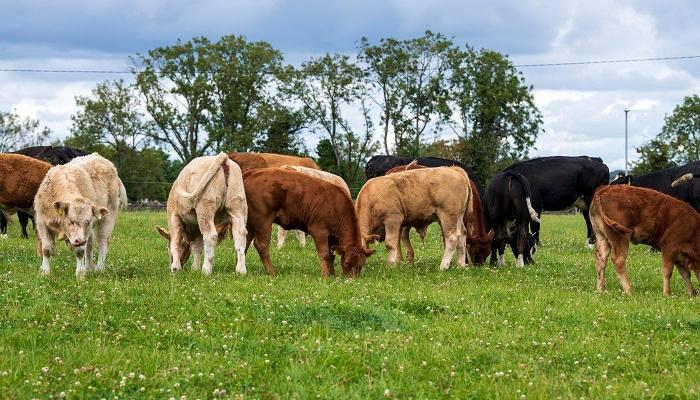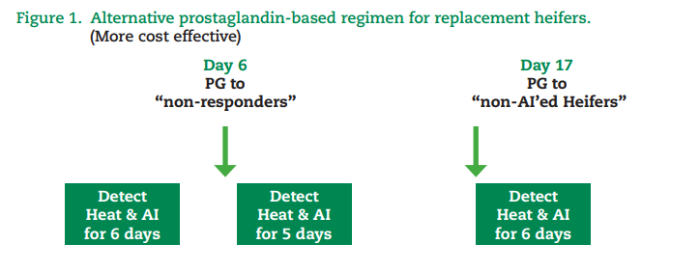03 May 2025
Synchronisation in the suckler herd

Timed AI based on the use of oestrus synchronisation programme can substantially reduce the labour requirements of heat detection and assembly of suckler cows.
Having been tested extensively at Grange, Catherine Egan, Teagasc Beef Specialist, and Prof. David Kenny, Head of the Teagasc Animal and Bioscience Research Department, fill us in on the most appropriate synchronisation programmes for suckler cows and heifers.
To develop and test a robust and repeatable timed AI programme for Irish suckler beef farmers, Teagasc conducted a large on-farm trial, which involved fixed-timed AI of over 2,200 cows on 85 herds throughout Ireland.
The synchronisation protocol used in this study is outlined in Table 1. An overall pregnancy rate of 55% to the timed insemination (first-time submission) was achieved, which is good considering that approximately 50% of the treated cows were anoestrous (not resumed heat cycles) at the start of the protocol.
When combined with repeat breedings, 80% of synchronised cows were pregnant in the first three weeks of the breeding season, which has very positive benefits for average herd calving interval and compactness of the subsequent calving season.
The benefits of using heat synchronisation include: align breeding and calving to best suit the availability of labour; 100% submission rate using fixed-time AI; and inducing heat in anoestrous cows.
Table 1. Recommended synchronisation regimen for beef cows ≥35 days calved at time of treatment
|
Day |
Action |
|
Day 0, am (Monday) |
PRID or CIDR insertion + GnRH at insertion |
|
Day 7, am (Monday) |
PRID or CIDR removal + prostaglandin + 400 iu eCG (also known as PMSG) i.m. at time of removal (Ideally tail paint cows or affix heat detection patches to cows) |
|
Day 8 (Wednesday) |
Cows will start to show standing heats late pm and throughout the night. Record cows in heat and those that are active |
|
Day 9 (Thursday) |
Inseminate all cows observed in heat in the evening of Day 9 and on Day10 Heat check cows and record all cows active or in heat (if required). Alternatively, inseminate all cows at 72 hours following progesterone insert removal and administer GnRH to cows not yet observed in heat. |
|
Day 10 (Friday) |
Continue heat detection and inseminate cows observed in heat. Alternatively, inseminate all cows not observed in heat at 72 hours post CIDR or PRID removal and administer GnRH to these cows at time of insemination. If heat detection is not possible, all treated cows can be inseminated once at 72 hours (or as close as possible to this time), though GnRH must be administered to all cows. |
|
Notes • All drugs are Prescription Only Medicines (POMs) and are under veterinary control. • Dosage of drugs: will vary according to drug and drug formulation. • Inadvertent administration of prostaglandin to a cow/heifer during the first 3-4 months of pregnancy will cause abortion. |
|
For best results with oestrous synchronisation in beef cows, it is recommended that:
- Cows are in a moderate BCS score (2.5 –3.0) at time of treatment. It is equally important that cows are a minimum of 35 days calved at time of PRID or CIDR insertion and are on a good plane of nutrition (plentiful supply of grass) for a minimum of 3-4 weeks prior to, during and after treatment.
- Synchronisation should only be used in herds where the level of management and in particular heat detection skills are high in order to detect heats and particularly repeat heats. Alternatively, a bull should be turned out with cows 7-10 days following the initial AI.
- Where sex sorted semen is to be used, it should only be used in females exhibiting standing heat and where the time of initial onset of heat is known. These cows should be inseminated with sex sorted semen at 16 to 22 hr after detecting the female in heat.
Synchronisation of replacement heifers
As the vast majority of replacement heifers should be undergoing normal heat cycles during the breeding season, there is a reduced requirement for incorporating an exogenous source of progesterone in the oestrous synchronisation regimen for heifers.
Consequently, prostaglandin-based regimens are the method of choice for use on replacement heifers. A cost effective regimen involves good heat detection initially carried out for six days and all heifers detected in heat are inseminated.
On the sixth day, all heifers not yet detected in heat are injected with prostaglandin. The injected heifers will respond to the prostaglandin and show heat 2-4 days after injection and should be inseminated as normal; conception rates of 65-70% should be expected. The remaining heifers not yet recorded in heat and inseminated can be treated with a second prostaglandin injection 10-11 days after their initial injection. Up to 80% of heifers will respond to one or two injections of prostaglandin. Using this protocol, drug use, semen costs and veterinary costs are minimised.

It is important that replacement heifers are well-grown (minimum 350-400kg depending on breed type) and are undergoing regular heat cycles.
There is an option to use a PRID/CIDR device in heifers using a similar protocol to what was outlined for beef cows above.
The options are to:
1). Heat detect and AI as normal, any heifers not showing heat, inseminate at 72-84 hours after device removal and administer an injection of GnRH.
2). Avoid heat detection and inseminate all heifers at 55-60 hours after device withdrawal. GnRH must be administered at insemination. This approach will ensure a 100% submission rate and induce ovulation in some non-pubertal heifers.
Pregnancy rates of over 75-80% have been achieved at Grange to a single timed insemination in 15-16 month old beef heifers using this regimen. It is imperative that heifers are bred to easy calving sires, as dystocia or calving difficulty can be four-fold higher in heifers than in more mature cows.
